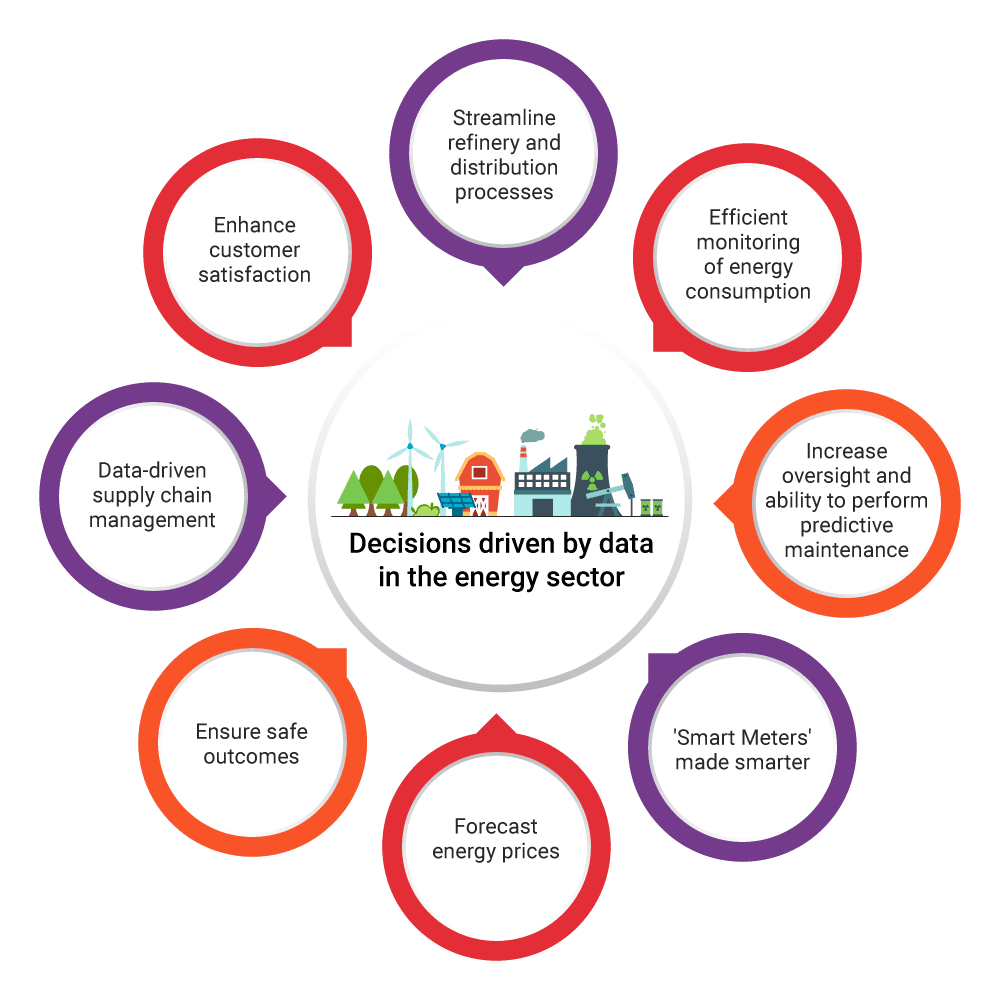Eight key benefits of Data Analytics
Imagine a day without energy.
The electric grid will be off, and there will be no vehicles! If you have no energy to turn on the television, how hard would it be to see the finale of the football leagues? As humankind evolved, Energy found its place as a fourth basic need, without which life is unimaginable. In addition to everyday life, energy is also a catalyst for industrial growth. Electricity and petroleum are two of the most critical energy sources used by multiple industries, including construction, hospitals, schools, transportation, industries, and telecommunications. In today’s era, the energy industry powers almost everything in the world.
But what powers the energy industry?
It’s the DATA!
Th energy industry sector has been testing the possibility of digital technology in the past two years, including experimenting with analytics, process digitization, and robotics. As a result, they been overwhelmed with data, coming from different sources such as research, growth, transportation, and distribution – making it challenging for businesses to keep track.
IoT, AI, ML, and cloud computing are just a few of the latest technologies widely adopted by the energy industry, which has resulted in the generation of a staggering amount of data. According to the IDC, there will be 41.6 billion IoT devices by 2025, generating 79.4 zettabytes of data! Think about the staggering amount of data that other technologies will add when adopted. Data volume, variety, and velocity are increasing due to the digital revolution and will increase many folds in the near future. Even though storing and extracting valuable information from such data can be a challenge, if analyzed intelligently, it can help the energy industry cope with some of the significant technical and non-technical challenges they face today.
How can energy companies leverage data to scale their business?
In the energy and utilities sectors, predictive analytics is largely untapped. Using big data analytics to reduce energy consumption and improve efficiency in the energy sector has become increasingly important. Big data analytics becomes more important as oil prices fluctuate, leading to higher expenditures on energy-related projects. Various machinery and equipment are monitored in the energy sector, making big data analytics even more important for decision making.
Here are some examples that pushed the energy industry to think about data for smart and safe decision making. In 2011, North Texas-based Luminant was fined $750,000 by state energy regulators for failing to deliver promised electricity to the grid following a more severe storm in North Texas. Another Texas energy company’s power plant buckled in January 2014 because of cold weather. In less than 12 hours, its generators failed more than a dozen times, contributing to the state’s electric grid collapse.
Energy and utility grid stress is not limited to Texas but applicable globally. Data about utilities is created by the grid infrastructure that transmits it. By analyzing grid data points, utilities can identify which assets require immediate repair or replacement. At the onset, its time for the Energy sector to harness the power of data to avoid such catastrophes. Organizations can easily analyze their data collected through sensors and devices for future predictions and avoid risk. to. Here are eight benefits of data-driven decision-making that every organization in the energy sector must consider for sustained growth.

- Streamline refinery and distribution processes:
According to McKinsey, the Oil & Gas industry faces a $200 billion performance gap. In their research, offshore platforms operate at a maximum capacity of 77% on average. When appropriately used, data-driven analytics can yield up to 30-50 times the investment within a few months. Therefore, oil and gas companies can streamline their distribution and refinery processes by using data science, and respond to market demands in real-time.
- Efficient monitoring of energy consumption:
Through high-resolution data of user consumption, customer behavior can be analyzed, demand can be forecasted, and energy generation can be optimized. Power system security depends on predictive maintenance and fault detection with advanced metrics based on data analytics. Machine learning algorithms can be used for weather prediction and increasing the efficiency of renewable energy sources such as wind and solar power.
Siemens, for instance, has incorporated big data analytics with smart meters to gain deeper insights from the smart grid, which in turn allows businesses to cut down on extra energy consumption and increase profit margins. Therefore, data analytics can manage power outages, determine peak times, and set energy prices.
- Increase oversight and ability to perform predictive maintenance:
In the world of Industry 4.0, companies can use sensors to collect behavioral data about their assets. This information can then be analyzed with the data collected by the rest of the power network using machine learning algorithms. Big data techniques can then be used to predict issues and help operations managers decide when to replace or maintain an asset. By predicting when an equipment needs maintenance, utility can maximize its equipment’s life and reduce the number of truck rolls, personnel in the field, and material stock, thus contributing to overall cost savings. Sensors embedded in transformers help the energy industry monitor and perform predictive maintenance.
- ‘Smart Meters’ made smarter:
The data collected from customer behaviour and smart meter usage determines which customers are likely to default on their payments. In addition, customers can now view their usage patterns, better understand how much energy they use, and predict their bills.
- Forecast energy prices:
As smart grids have proliferated, power users have increased, and renewable energy has been developed in large numbers. More and more factors affect the electricity price, making price forecasting more difficult. The accuracy of forecasting is greatly influenced by data processing. Power companies can predict future prices using advanced analytics and modelling and adjust their operating model accordingly.
- Ensure safe outcomes:
The energy sector faces numerous challenges, such as predicting production demand, improving efficiency, and optimizing preservation operations. Energy enterprises can make safe decisions by collaborating and analyzing data, leading to intelligent data-driven decisions.
- Data-driven supply chain management:
Statistics and quantifiable performance indicators have been driving supply chains for a long time now. Despite this, the kind of analytics that is currently revolutionizing the industry and absent in many organizations isreal-time analyses of massive and rapidly growing unstructured datasets. However, if intelligently analyzed and tiered into cold and hot data buckets, energy companies can use data to balance demand and supply. Connecting smart meters, smart grids, and real-time weather information systems with big data can simplify dispatch decisions, increase efficiency, organize inventory, and increase reliability.
- Enhance customer satisfaction:
2.6 times more revenue is generated by a totally satisfied customer than a somewhat satisfied customer. The journey from somewhat to totally satisfied customer has been enabled by data if used intelligently! With the help of data analytics, companies in the energy sector can engage customers in highly personalized environments, increase customer satisfaction, and promote new products.
In the energy and power sector, big data analytics is proved to be one of the biggest catalysts for improving business performance. The above benefits are just a few of the many business values that data-driven decisions can provide to the energy industry.
To become a successful data-driven enterprise, energy enterprises need to take two main approaches:
- A Cloud-first strategy
- Gain maximum knowledge about their data
The easiest and quickest path towards becoming a data-driven enterprise
Data analytics in cloud computing allows enterprises to consolidate their information and better understand it. Cloud-based data warehouses enable data to be accessed by all users. Moreover, data consolidation can also help create real-time prediction models through data mining. Hence, being a data-driven energy enterprise starts with being on the cloud!
Furthermore, similar to conventional hardware- or services-centric businesses, energy companies have historically been less inclined to have vital data, analytics, or software-centric (digital) product cultures. In recent findings by research firm IDC, 90% of all unstructured data globally was created in the last two years. The energy industry is no exception with unprecedented generation and collection of data. This has led to data silos, regulatory non-compliance, security breaches, and reputational risk. If you are looking for a seamless transition to the cloud and better usage of your data with analytics, Data Dynamics is here to help!
When enabling cloud migration, compliance and security are of primary concern. With the Data Dynamics Unified Data Management platform, organizations can analyze data for actionable insights, make data-driven decisions, , become responsible data custodians, and comply with the latest data protection laws. For energy companies, the key to unlocking data-driven potentials lies in understanding unstructured data. Our platform makes it easier for you to understand your unstructured data and help you manage it seamlessly. One intelligent platform, many competitive advantages!
Click here to check out how Data Dynamics utilized the Azure File Migration Program to help one of the world’s seven multinational energy “supermajors” Fortune 50 companies accelerate its net zero emission goals while driving digital transformation.
Learn how you can begin your cloud migration journey in only three steps with the Azure File Migration Program– zero cost migrations into Azure with Data Dynamics’ StorageX, sponsored by Microsoft. To know more, contact solutions@datdyn.com or click here to book a meeting.
*Terms and Conditions apply






